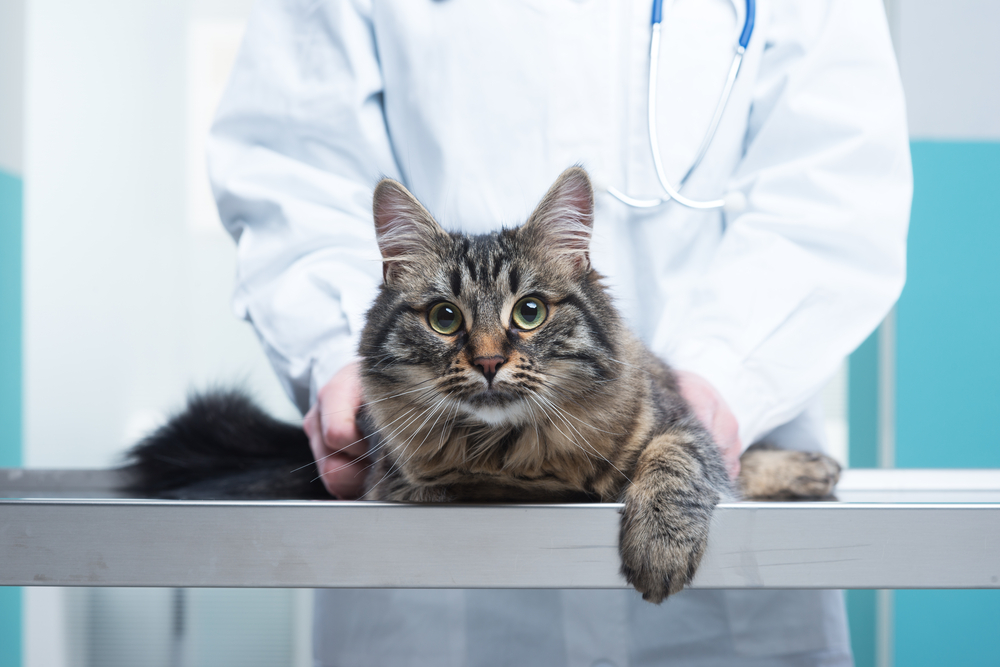
A chondrosarcoma (CSA) is a malignant, invasive and fast spreading tumor in cats. It is relatively uncommon in cats, representing about one percent of all primary tumors. A CSA of the nasal and paranasal sinuses arises from the mesenchymal tissue, a connective collagenous tissue that is found throughout the body, and metastasizes to other parts of the body, including the nasal bones. It usually occurs on one side of the nasal cavity and extends to the other side over time.
Older cats are at increased risk, but any age can be affected, and male, neutered cats appear to be at higher risk. The Siamese breed has been reported to be predisposed. In addition, it is believed that animals in urban areas may be more at risk for developing nasal tumors than animals in rural areas.
The exact cause is still unknown but because there is some anecdotal evidence that urban animals are at higher risk for nasal tumors, suggesting an association with pollution.
Your veterinarian will need a complete background medical history leading up to your cat's disease symptoms. Routine blood tests include a complete blood cell count, biochemistry profile, urinalysis and platelet count. The results may show normal levels. Your veterinarian will also examine the blood samples for evidence of fungal or bacterial infections. Cryptococcus is a common mimic of nasal tumors in cats.
Radiographic studies can be helpful in confirming the diagnosis, but even this type of diagnostic method is challenging. Computed tomography (CT) scans and magnetic resonance imaging (MRI) will often produce a more substantial image of the extent of invasion. An endoscope -- a tubular device with an attached camera that allows for a closer look at the diseased area -- can also be used examine the internal structure of the nasal canal, and may also be used to collect tissue specimens for biopsy, but because of the small space, this can be difficult. Other methods for collecting tissue and fluid samples may be employed, including fine needle aspiration, and suction. Biopsy is the only way to conclusively diagnose nasal cancer.
Your veterinarian may also take radiographs of other areas of the body to evaluate if metastasis is taking place.
This is a highly aggressive and life-threatening tumor that will need prompt treatment in most cases. Because of the area being considered, surgery can be dangerous. Radiation therapy is usually the treatment of choice for nasal tumors. Radiotherapy may also help in prolonging the life spans in those cats for which tumors are inoperable. Chemotherapy is also recommended for some cats, but its long term effectiveness has not yet been evaluated for CSA in veterinary patients.
You may be advised to revisit your veterinarian every three months for follow-ups after the initial treatment. Your veterinarian will evaluate your cat to see if any metastasis has occurred during this time. Routine X-rays will be taken of the affected part, as well as other body areas, to check for recurrence or spread of the tumor. The decision to go forward with surgery or chemical therapy will be based on the actual prognosis at any given point during treatment. In some cases, end of life pain management may be in order.
Always seek advice and instructions from a veterinary oncologist before giving chemotherapy medications, as these drugs are highly toxic to human health. Pregnant women in particular should take extra care while administering chemotherapeutic drugs to their pets. Chemotherapy medications have the possibility of toxic side effects, so your veterinarian will need to closely monitor your cat's stability, changing dosage amounts as necessary.
 Anemia, Nonregenerative in Cats
Nonregenerative Anemia in Cats
A decrease in red
Anemia, Nonregenerative in Cats
Nonregenerative Anemia in Cats
A decrease in red
 Increased Appetite in Cats
Polyphagia in Cats
Polyphagia is the name of a me
Increased Appetite in Cats
Polyphagia in Cats
Polyphagia is the name of a me
 Brain Inflammation in Cats
Encephalitis in Cats
Inflammation of the brain, a
Brain Inflammation in Cats
Encephalitis in Cats
Inflammation of the brain, a
 Colonic or Rectal Inflammation in Cats
Colitis and Proctitis in Cats
Histiocytic ulcerat
Colonic or Rectal Inflammation in Cats
Colitis and Proctitis in Cats
Histiocytic ulcerat
 Dark Spots on the Eye in Cats
Corneal Sequestrum in Cats
Corneal sequestrum occ
Dark Spots on the Eye in Cats
Corneal Sequestrum in Cats
Corneal sequestrum occ
Copyright © 2005-2016 Pet Information All Rights Reserved
Contact us: www162date@outlook.com